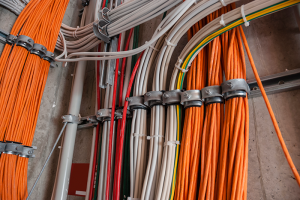Efficiently managing facility assets

Facilities managers should review each individual asset or asset class from the highest priority to the lowest.
Image by Getty Images
A commonly used phrase in the health care engineering field is, “We follow manufacturer’s recommendations.”
But what if manufacturer’s recommendations aren’t the most effective way to maintain equipment? In such cases, an alternative equipment maintenance (AEM) program might be a better option.
Regulatory evolution
In 2011, the Centers for Medicare & Medicaid Services issued a Survey and Certification Letter acknowledging that following manufacturer’s recommendations may be restrictive and excessive. It allowed for the implementation of an AEM for the frequency of some facility and medical equipment but not the maintenance activities.
To implement the AEM program, a qualified person was required to assess equipment on their risk to patient and staff health and safety. Equipment found to be critical to patient health, as well as new equipment with no maintenance history, was not approved for the AEM plan.
Over the next few years, AEM was incorporated into The Joint Commission standards, and in 2013, alternate maintenance activities could be added to the AEM plan. Finally, in 2017, 100% of AEM- defined preventive maintenance (PM) was required to be completed.
The Joint Commission’s Environment of Care, (EC).02.05.01, Element of Performance (EP) 5, requires that an organization identifies in writing the activities and frequencies for inspecting, testing and maintaining all operating components of the utility system. These are in accordance with either manufacturer’s recommendations or are in an AEM plan.
EP 7 states, “a qualified individual uses written criteria to support the determination of whether it is safe to permit operating components of utility systems to be maintained in an alternate manner.” Additionally, EC.02.05.05, EPs 4 and 6, require that assets on an AEM have 100% of PM completed.
It is likely that most health facilities managers are following an AEM on some equipment without even knowing it; anytime one is not following all the manufacturer’s recommendations exactly, they are performing an AEM on that piece of equipment. Examples include checking each of the electrical outlets once a month and checking the air filter twice a month on each one of the ice machines.
A documented AEM will show that the facilities manager has taken the time to understand the recommended maintenance and has chosen to implement a program that fits with the organization while proactively maintaining its assets.
Developing a plan
To develop a plan, health facilities managers should first learn how to choose their expert team to assess risk from their organization’s equipment inventory. From there, they can optimize their PM strategies as appropriate. Finally, they can document their decisions, measure their results and capitalize on the data collected.
The following steps provide a closer look at the process:
Step 1: Identify a qualified person. One or more qualified individuals are required to assess equipment for the AEM plan. Generally, a qualified individual possesses a recognized degree, certificate, professional standing or skill and, by knowledge, training and experience, has demonstrated the ability to deal with the subject matter, the work or the project at hand. This should be documented, up to date and readily accessible.
The qualified individual or team developing the AEM plan must communicate the intent to the technicians. They should explain the intent of the AEM and what is expected of them. Without clear communication, technicians may see this as a punitive effort. Facilities managers should ensure they are updated with the progress as the plan develops and is implemented.
Step 2: Validate inventory. Managers should ensure all assets that require PM are identified and tagged. They may even consider combining this effort with a facility condition assessment. They should identify the manufacturer, make, model, serial number, associated components, year installed, redundancy and, if applicable, area served of each asset.
Gathering this information while validating the facility’s inventory will save time when ranking assets by risk. American Society for Health Care Engineering (ASHE) members should consider using the asset risk management system tool at ashe.org/arms. This tool examines the current state of the facility’s asset management philosophy and identifies opportunities to programmatically build in regulatory and accreditation compliance.
Facilities managers also should ensure their assets have similar nomenclatures and the same types of assets are not named in different ways, such as “air-handling unit” and “AHU.” Managers should consider using industry standard language for their assets. This enables building components to transition from construction into the health care facility’s computerized maintenance management system (CMMS), effectively transitioning spaces from project to operations.
Step 3: Assign assets for risk. Facilities managers should determine a standard risk classification structure for their assets, such as Categories 1-4 in Chapter 4 of the National Fire Protection Association’s NFPA 99, Health Care Facilities Code, where Category 1 may cause severe injury or death, and Category 4 would have no effect on patients or staff.
Resources
Some items to consider when assessing risk are: What is the impact of failure? What is the criticality of the area the asset serves? What is the frequency and intensity of the maintenance requirements? Is there redundancy, and how quickly can service be duplicated or restored?
Facilities managers should ensure that all risk decisions and reasonings are documented, as well as the individual or team that made the final decision. They should label each asset’s utility function for easy identification, such as noncritical, safety and/or security, critical, life support, infection control or life safety.
Step 4: Rank and prioritize assets. Once health care facilities managers have risk-ranked the assets, they can determine which do not qualify as part of the AEM plan. EC.02.05.01, EP 5, states that life safety systems, medical laser equipment, and radiological and imaging equipment are not eligible for an AEM, and the PM must follow manufacturer’s recommendations.
An organization may decide that other assets are not eligible for an AEM based on their risk ranking or areas they serve. For example, it may consider continuing to maintain all equipment that serves the operating rooms per manufacturer’s recommendations.
The qualified individual or individuals should decide what constitutes a high-risk asset, and whether they are eligible for the AEM program. Once managers have identified the assets that must continue to follow manufacturer’s recommendations, they should ensure all activities and required frequencies are accurate in the CMMS.
Step 5: Determine eligible assets. With the life safety and critical assets removed, facilities managers can determine which assets are eligible and appropriate for the AEM plan. They should consider breaking down assets further into utility classification risk classes such as infection control, nonclinical, transport and environmental support. From there, facilities managers can add risk levels, maintenance requirements and availability of redundancy that were gathered during the asset inventory review to have a complete risk score of each asset.
Step 6: Define schedules and activities. Once facilities managers have decided which assets will be part of the AEM plan, they can establish the criteria for AEM PM. They should ensure the maintenance and repair history that is available is documented and tied to the asset in the CMMS. For newer assets with no history, they should use industry standards until a maintenance record has been established.
Managers should review each individual asset or asset class from the highest priority to lowest. They should look at the manufacturer’s recommendations for each and either accept the standards or adopt new strategies and/or frequencies.
Additionally, facilities managers should trend maintenance and repair history and adjust PM activities and schedules to ensure reliability, reduce risk and manage costs. They should utilize industry standards for alternative schedules and ensure they do not increase the risk of failure or harm to a patient. Managers also may decide to exclude run-to-fail equipment. However, they should ensure this decision is documented.
Step 7: Document. The AEM asset inventory and PM schedules are now complete. Next, facilities managers must fully document the program. They should consider creating an official, published policy for their organization to ensure awareness of the program.
The policy should reflect the processes in place. This will also be the document that is shared with The Joint Commission surveyors when they review the facility’s documents, so caution is advised. “Don’t write yourself into a corner,” says Benjamin Leutze, CHFM, CHC, former senior advocacy associate with ASHE. “If it is in the policy, The Joint Commission will hold you to it.”
Documentation should include the detailed asset list with risk rankings and classifications of each asset, resource information on how alternate schedules were developed and evidence that the AEM program is regularly reviewed and is effective.
Post-implementation
Once a facilities manager has implemented an AEM program and has full control and understanding of the assets in their facility, they can use the data to make educated decisions on which capital asset to upgrade and how to prioritize each piece of equipment.
With this data, managers can better anticipate the expected useful life of each asset and plan for replacement prior to failure. The information also can be used to plan for future capital upgrades and ensure there is money in the budget.
Additionally, the following tasks must be maintained after implementation:
Communication. Facilities managers will need to present their AEM plans and documentation to The Joint Commission during the triennial survey. They should ensure that everyone in the department, from leadership to technicians, understands the full intent of the plan and how it is being implemented, and have a basic understanding of the types of equipment that are included in the plan. Everyone should understand why the organization has chosen to implement an AEM and the expected benefits of doing so.
Continuous improvement. An AEM program must be reviewed at least annually and possibly more often to ensure risk is mitigated proactively. This usually can be accomplished automatically by reporting functions in the CMMS.
Facilities managers should study trends, look for increases in unscheduled repairs and make changes quickly to PM levels if the data indicates increased risk from an alternate schedule. They also should evaluate equipment in the AEM program to ensure no degradation of equipment reliability. Additionally, equipment malfunctions should be evaluated, investigated and documented in the CMMS. Managers should determine if the malfunction was related to the AEM program and standardize how equipment is sequestered if it is found to be malfunctioning.
An AEM plan should be adjusted as data is analyzed and PM schedules are altered to optimize performance.
The payoff
Implementing an AEM program is a daunting task, but the payoff is having a better understanding and more control over the assets a facilities manager is responsible for, an optimized PM schedule that fits the team and facility, and better planning capability to upgrade the facility’s capital equipment.
Taylor Vaughn, MBA, CHFM, CLSS-HC, is a facility manager at Children’s Health in Dallas. She can be contacted via email at taylor.vaughn@childrens.com.




